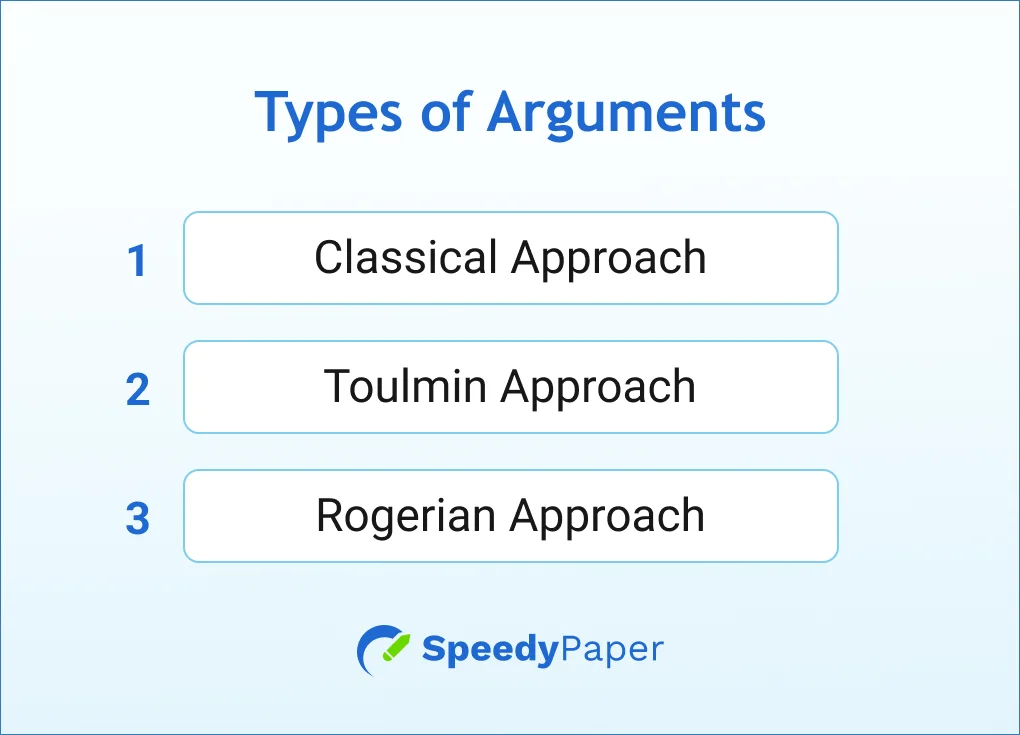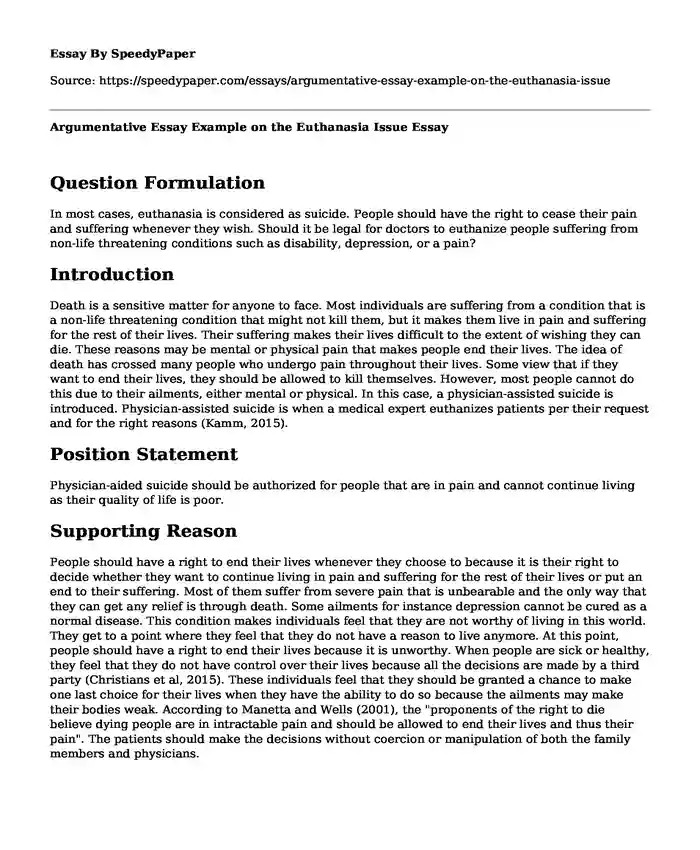
How to write an argumentative essay: step-by-step guide for students
|
Table of contents: |
You did your best to write a perfect argumentative essay, but still, the professor didnt give you an A+. Its not a reason to throw in the towel, there are so many assignments ahead of you. And with the help of our checklist, you will make the next argumentative essay your best. Make sure to hit all four of our points to ensure the highest grade.Besides, do not forget about a chance to get qualified and professional paper writing help online. Specify the requirements and let experts take care of your academic success.
What is an argumentative essay?
Let's start this academic journey by looking at a key question. An argumentative essay is an assignment that takes a stance on an issue. As a student and writer, you must persuade readers to understand and support your point of view about a topic. During this process, you will need to provide them with clear reasoning and solid evidence to back up your statements. As you can see, the argumentative essay definition is quite simple, but creating such a paper can take a lot of time. Here are the skills you need to craft an argumentative essay well.
- Research skills. Get ready for a long research process, gathering facts and important details for your paper. But first, you must separate the grain from the chaff and find important information.
- Writing skills. Writing an argumentative essay can be easy if you do speak your mind. Learn to formulate your position and construct paragraphs based on your information.
- Analytical skills. When analyzing each fact, claim, or argument, you should clearly understand why this information is relevant to your essay and how you can present key data.
To understand how to write a process analysis essay and other papers, you must understand the basics to craft assignments successfully. Now let's move on to the next important aspect.
Argumentative essay structure: putting the puzzle together
Now let's talk about the parts of an argumentative essay you need to craft. Like any similar academic paper, your argumentative essay will consist primarily of five paragraphs divided into three parts.
- Intro. It is the first part of your paper, where you should show your topic, provide background info and outline the evidence you will present (including your thesis).
- Body paragraph. Your argumentative essay body paragraph (paragraphs) is intended to explain why you support your thesis. Get ready for three paragraphs where you must explain why the reader should agree with your position. Use examples, research, statistics, and text citations to support your general idea.
- Conclusion. Surely you have already understood how to start an argumentative essay. But your final paragraph should restate your thesis and summarizes all your arguments. Of course, a perfect conclusion will always appeal to readers' emotions, and you should not forget about it.
Now you know all about the general structure and how to write a conclusion for an argumentative essay. Be careful and follow your outline strictly.
Academic approaches: three main types of arguments to remember
As an argumentative essay writer, you must know how to use the three academic approaches properly. Here are the main ways to structure your essay.
Classical approach
The structure of an argumentative essay begins with presenting your main argument or stating your opinion. Then, according to this approach, you need to convince the reader why your position is right. Most freshmen will probably run into this approach as it suggests the simplest line of thinking to follow. But, as a general rule, the classical approach is ideal for situations where your key audience doesn't have much information or a strong opinion about the topic you want to research.
Toulmin approach
Writing an argumentative essay is difficult if you need to provide iron-clad evidence. Visualize your claim, present grounds to back it up, and justify that your grounds are linked to the claim. Such an argumentative essay approach emphasizes one side, hinging particularly on facts that make a claim difficult to argue. In other words, you need to know how to end an argumentative essay like a pro.
Rogerian approach
This approach is suitable if your argumentative essay is not aimed at providing a single opinion about the topic. Instead, your job is to present the problem, acknowledge the opposing side, and state your point of view. You should also explain why your position is the most beneficial to the reader. At the same time, this approach acknowledges both sides and presents the middle ground.
Four steps to craft a solid argumentative essay
You are getting closer to your goal, but there are still important nuances to consider. For example, writing an argumentative essay can turn into a nightmare if you don't have prior experience. That's why you should check out these steps to help you stand out.
Step 1: Find good argumentative essay topics
Imagine that your professor gave you academic freedom. What essay idea are you going to choose? What are you interested in writing about? Some students opt to turn to an online essay writing service when they find it hard to pick the right topic for their assignment, and it is an optimal solution in this case. At this stage, many students find themselves a little discouraged by the abundance of paths they can take. So this is why you should check out good argumentative essay topics. Such a strategy will give you more ideas and a solid springboard for further writing activities.
- Recreational marijuana should be permitted.
- Should animals be In zoos and aquariums?
- Marijuana should be legalized in the US.
- Is technology good or bad? Argumentative essay in the example of 1984 by George Orwell.
- Are we too dependent on computers?
- An argumentative essay to the topic "Perseverance."
- Argumentative essay on kids playing football.
- Fast food industries and health.
- The Mercy journals.
- Corporal punishment in schools.
- An open letter to gun control agencies.
- Argumentative essay on the euthanasia issue.
- Should it be a requirement to spay or neuter your pet?
- Is technology destroying empathy?
- Argumentative essay on abortion.
- The number of rental mopeds should be limited.
- Argumentative advertisement essay.
- Guns should be controlled.
- College students should not be paid.
- Argumentative essay on Obesity and Junk food.
- Immigration: an argumentative essay.
- An innocent guy character in literature works.
- Argumentative essay of children's rights.
- Addiction to pain killers.
- An argumentative essay on smartphone controversy.
- Animal testing benefits.
- The Matrix, Skepticism, and the Mind-Body Problem.
- Negative peace - argumentative essay.
- The importance of games.
- All the president's men – an argumentative essay.
- Asking Mr. Bill for an A.
- Freedom of speech limits.
All of these topics for argumentative essay works are perfect. Pick any topic or combine a few ideas to start the writing process. Also, be sure to check out our guide on writing discursive essays!
Tip from SpeedyPaper
Start searching for topics only after your professor gives you the freedom to choose. Surely you will be upset if your original idea is rejected.
Step 2: Conducting research
Your research process is very important for creating an argumentative essay. Any of your claims or ideas should have a solid foothold. For example, you must have proof if you claim that the sky is blue and the water is green. Here are the key steps to follow.
- Choose your side.
- Pick the right argument.
- Find the supporting sources.
- Organize your evidence.
- Check the validity of your info.
Systematize all academic sources or the results of your research. Formulate key claims and ideas. Your reader (professor) should not be left with counterarguments or objections to the information you provide in your essay. So writing an argumentative essay is like walking on hot coals. One false step and you risk failing your mission. And check the criteria for the validity of your info.
- Accuracy;
- the credibility of sources;
- timeliness;
- objectivity or bias;
- reliability.
As you can see, not everything is as scary as it seems at first glance. However, if you follow these tips, you can achieve the desired result.
Step 3: Crafting an argumentative essay outline
Your outline is a very important detail that will allow you to start the writing process like a pro. Here's what you should add to your outline, so you don't get overwhelmed by the sheer amount of information. Sometimes even a good argumentative essay example is not enough to understand the entire writing process, so here's what you need to know.INTRODUCTION
Your intro is meant to present your topic and key ideas. Try to succinctly formulate your general positions and goals so that the reader understands your messageHOOK
Tip from SpeedyPaper
You should check paper samples to create a top hook to grab your reader's attention. Also, pay attention to how companies create ads. You can get some writing ideas even by watching promotional videos on YouTube!
BACKGROUND
Background information is crucial for presenting your topic, ideas, and arguments. Why is your research so important? Why the information you provide is so important? Why did you go this way, and what is the idea behind your work? Your background should prepare the reader for key arguments and possible ideas.
THESIS STATEMENT
A thesis statement is a sentence that sums up the central point of your essay. It is the most important detail in your introduction, as it visualizes your research's key idea and meaning. Try to write this sentence as clearly and simply as possible so that the reader (professor) does not have dissonance or false expectations.
BODY PARAGRAPHS
As a rule, you will have to craft three body paragraphs. Use one argument or idea per part. Don't pile on many facts; otherwise, your ideas will look like a tag cloud. You should also take care of proper transitions so that all your paragraphs look solidTOPIC SENTENCE
Your topic sentence introduces a paragraph's general idea and supports your essay's main thesis. That is why do not forget that brevity is the soul of wit. Formulate all key proposals with due attention to detail.
CLAIM
EVIDENCE
Any claim must be supported by evidence. For example, if you claim that a particular type of flower smells good, then you must have proof of your claim. So get ready that your words may not be enough, but the results of certain studies can correct the situation.CONCLUDING STATEMEN
This very important statement resonates with your topic and general idea. Try to add all the important nuances to this statement so that your paper looks credible and solid.CONCLUSION
It is the final part of your paper and the place to summarize your research. Finally, prepare a springboard for a quick review of the work and highlighting the results.RESTATE THE THESIS
The final part of your paper restates your thesis and summarizes all the arguments in your body paragraphs. Again, be concise and state your position clearly to finalize your research.BRIEF SUMMARIZATION OF SUB-ARGUMENTS
It is another important paper that allows you to briefly visualize your main ideas and sub-arguments supporting your main arguments.OVERALL CINCLUDING STATEMENT
Consider this the final note on your academic track. The concluding statement is that paper part, after which all arguments and discussions no longer make sense.
Step 4: Editing and proofreading
This process is critical to eliminate all grammar and spelling mistakes, as well as all unclear ideas. Then, reread all your suggestions and rewrite the poor paper parts. This strategy is very important for students who want to get high grades. Please, make sure to do the following:
- Take a break after you've written your draft, and get back to work after a while.
- Check grammar and spelling.
- Check your evidence arguments.
- Have someone check your argumentative essay.
And don't forget the questions you should ask yourself before submitting your paper.
- How clear are your thesis statement and arguments?
- Are all your arguments clear and coherent?
- How good are your supporting examples for arguments?
- What about counterarguments and your reaction to them?
- Is your conclusion a springboard for future research on the topic?
Be careful and analyze each question carefully. Your argumentative essay should be carefully polished.
Tip from SpeedyPaper
In addition to editing and proofreading activities, you should use plagiarism checkers. Each of your essays must be original, so try to rewrite plagiarized paper parts.
Argumentative essay tips
Every freshman should memorize these tips and keep them as commandments. Here are some tips to help you reach your desired goals.
Pick good topics
Never take complex topics that are too tough for you. Sometimes it is better to start the research process in a field you are familiar with.
Turn your topic into a solid question and answer it
Put the main question in the essay's title or the first sentences. You should also build up to answering that question in your thesis statement. This way, you can start your essay and intrigue your readers (professors). Finally, try to find some argumentative essay hook examples to understand what writing tricks are most effective for the academic process.
State your argument and then refute it!
This strategy is ideal for demonstrating your credibility. Writing an argumentative essay can become a controlled process if you introduce an idea that contrasts with your belief. The next step is to explain why you disagree with it immediately. This approach is ideal for visualizing the pitfalls of each idea or statement from different angles.
Briefly outline your main points
Try to introduce your main point and explain how you'll back it up. For example: "You can turn an old sedan into a comfortable car if you replace the interior upholstery and take care of the noise isolation." This argumentative essay method is effective because it gives readers a clear idea of everything you'll discuss in your essay. Think of it as something like a roadmap to help keep you organized.
Find good paper examples
Don't forget that all students should check the argumentative essay example set to understand the writing process and how to create paragraphs. Check out all the examples that resonate with your topic, and you will understand which direction to move. But do not copy other people's ideas, but try to follow a new path. All these tips will help you stand out from the crowd and avoid pitfalls. Try to follow the general instructions, and academic success awaits you.
Tip from SpeedyPaper
Look for as many tips and ideas as possible to help you write your first essay. Also, don't forget that your professor can give you good advice that will give you the green light.
Common mistakes to avoid when writing an argumentative essay
A primary flaw lies in the creation of the thesis statement. Your argument falls flat before it begins if it lacks focus or clarity. Another common mistake pertains to ignoring counterarguments. A strong argumentative essay considers all perspectives. Additionally, picking suitable argumentative essay topics often stumps students.Lastly, while you may feel tempted to buy argumentative essay papers, remember that writing is an integral part of your learning journey. Through writing, you cultivate critical thinking, research, and argumentation skills that will serve you beyond the classroom.
Argumentative essay examples
Surely you will need good argumentative essay examples to start your writing activities. Here is a sample that will clarify the situation!

Conclusion
As you can see, creating an argumentative essay is not as difficult as it seems at first glance. But you should be consistent and follow all the important steps. Be careful and do not deviate from the overall requirements. And don't forget that sometimes professors can give you non-standard instructions, so learn to be a flexible writer.




Comments (0)
Thank you for your comment! 🌟
It has been submitted and is awaiting moderation. Stay tuned—it will be visible soon!